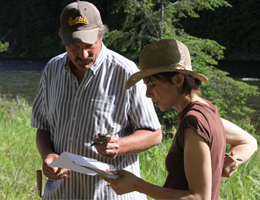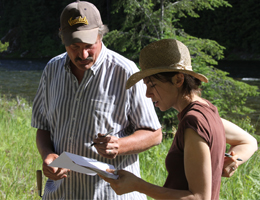Kelly Creek Speaks
University of Idaho archaeology team discovers some of the oldest evidence of human activity in the state
(First published in the May 2012 issue of Here We Have Idaho)
See the current issue

At an archaeological dig site in the Clearwater National Forest, a tribal elder gathers around a campfire to tell coyote stories to University of Idaho researchers, who are weaving their own narrative of a sort.
Against the backdrop of emerald Kelly Creek, a renowned fly-fishing destination in Idaho’s north-central wilderness near the Montana border, the researchers are piecing together the story of the region’s earliest indigenous tribes, told through artifacts that represent some of the state’s oldest evidence of human activity.
Excavation has stretched over the past two summers, with U-Idaho archaeologists and their field school students finding and cataloging about 11,000 items, including prized hunting tools – some of them 12,000 or more years old.
Among the most notable finds are 354 implements. They include anvil and hammer stones, projectile and spear points, blades and knives, an abrader used to smooth wooden and bone tools, and two stone sinkers from ancient fishing nets.
The additional discovery of spear points shaped from non-native lava rocks – obsidian and green vitrophyre – point to the tribes’ high mobility and their trades with Native American tribes living in southern Idaho, Oregon and Montana.
“This is really important. It’s not the biggest dig in the state – but it is among the very oldest,” says University of Idaho archaeologist Lee Sappington, a foremost authority on human history on the Columbia Plateau. An associate professor of anthropology in the College of Letters, Arts and Social Sciences, he’s ultimately responsible for the project.
Recently, carbon dating of some of the uncovered relics show that aboriginal people first frequented the place some 2,000 years earlier then previously known. Archaeologists refer to the time period as the region’s Windust phase, the first on a timeline that runs up to the present.
“It’s really significant to find anything this old. It’s places like this where we can make the most contributions to the historical record,” says Sappington, who’s played a primary role in 25 significant archaeological explorations on the Clearwater River over a 37-year career, dating back to his 1976 U-Idaho graduate studies in archaeology after the construction of the Dworshak Dam.
While dwarfed in size compared to the sprawling 1960- and 1970-era archaeological investigations required prior to dam and highway construction, Kelly Creek’s secrets are just as pivotal. Sappington says they’re illuminating the inaugural chapters of the region’s indigenous people.
Sappington acknowledges the sacred nature of such work. He seeks approval from the tribes’ stakeholders before the first layer of dirt is ever removed.
"The tribal elders like what we do,” he says. “It’s a positive thing. We’re helping people re-discover their history. We’re finding things that nobody knows about and bringing them into awareness.”
Under Sappington’s oversight, Laura Longstaff, a U-Idaho graduate student, is coordinating the many details of the dig’s day-to-day operations. As the crew boss, she’s responsible for the integrity and accuracy of the exploration. She’s also in the process of analyzing the Kelly Creek data for her master’s thesis, with Sappington serving as her major professor.
It’s rare for a professor to recommend that a graduate student take charge of a study of this scale. But Sappington says Longstaff has what it takes to helm this sort of operation.
Over the past two field school seasons, she’s proven herself to be a gifted researcher and a talented mentor and teacher to scores of undergraduate students who’ve participated in excavation work.
Longstaff says when combined with the spear tip, projectile points and net sinkers found so far, Kelly Creek’s natural features elucidate its purpose: It was a seasonal hunting and fishing ground used by the ancestors of the Nez Perce, the Coeur d’Alenes and other indigenous Indian tribes.
They harvested its elk, deer, bison, rabbit and beaver, according to residue on some of the tools. The waters of nearby Kelly Creek would have rippled with massive steelhead trout and salmon, says Sappington.
Blanketed by snow until late spring, the area would have been accessible only by foot for a few bountiful months each year. Yet for thousands of years, generations of American Indians trekked to this abundant and beautiful place – until the 1600s or 1700s, when they mysteriously abandoned the site, never to return.
In the early 1900s, the U.S. Forest Service began its continuous management of the area. Today, it’s part of the North Fork Ranger District. Following the agency’s decision to construct new buildings on the property, Sappington was hired to conduct a cultural assessment of what has proven to be a historically significant site.
A 2009 survey using ground-penetrating radar first identified potentially rich pockets of ground that the archaeologists used as starting points in their search. Working in their favor were the facts that centuries of silt deposits and a lack of agricultural activities had perfectly preserved the area, securing its buried treasures. The team’s discovery that very first summer of a spear point from the Cascade Phase (5,000 – 8,000 years ago) whetted their curiosity for what was to come.
In addition to the Windust objects, Kelly Creek has given up implements from every one of the region’s archaeological time periods, from 12,000 to about 200 years ago.
Still, debitage – slivers of rock left during flint knapping and toolmaking – comprises the remainder of the collection, says Longstaff. Yet it, too, is telling. Its sheer bulk demonstrates the volume, frequency and types of tools that were being made, she says.
"Our findings at Kelly Creek will be a great contribution to science – perhaps one of the biggest for the next 10 years in terms of filling in the full record of Idaho’s archaeological discoveries on the Clearwater River’s North Fork,” says Longstaff.
Despite the artifacts’ rarity, they’re a means to an end for the researchers, she says.
“They represent a whole lot of complex behavior and reasoning that went into procuring resources. We’re piecing together evidence of a lifestyle,” she says. After the dig’s conclusion, it’ll take several more months to analyze and interpret the wealth of information.
She’ll document it all in her thesis and expects to co-author at least one journal article about Kelly Creek. After that, staff members at U-Idaho’s Alfred W. Bowers Laboratory of Anthropology will curate the dig’s results. The Idaho State Historical Society’s Archaeological Survey will manage the collection in the long term.
Sappington predicts that future archaeologists will have even more sophisticated technology and knowledge with which to one day re-examine all of Kelly Creek’s artifacts, scaled drawings, photographs, soil samples, field notes, test results and GPS coordinates.
For now, Longstaff says, she’s eager to get back into the field. She’s happiest when immersing herself in the location’s landscape and its history.
“Sometimes I look around and imagine what it looked like 5,000 or 10,000 years ago. I imagine people working on tools, a fire or hearth somewhere. Maybe going down to the river to pick out a rock to process as a tool or weaving a fish net from native plants,” she says. “These people had such a complex knowledge of the world around them,” she adds. “Slowly but surely we’re putting all these pieces together, and one day we’ll be able to reconstruct events based on our findings. We’re trying to answer as many questions as we can.”
Article by Paula M. Davenport, Here We Have Idaho







